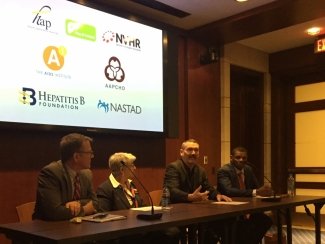The Centers for Disease Control and Prevention (CDC) conservatively estimates that 3.5 million people in the U.S. are living with the hepatitis C virus (HCV). This number is likely an underestimate due to disjointed HCV surveillance across the nation. Injection drug use is now the primary risk factor for new HCV infections. Because an estimated 80% of new HCV infections occur among people who inject drugs (PWID), it is critical to prioritize this population for screening, linkage, and treatment both to address the community’s healthcare needs and to halt the increase in new infections.
Despite expert guidance from American Association for the Study of Liver Disease (AASLD)/Infectious Disease Society of America (IDSA), The European Association for the Study of the Liver (EASL), the International Network on Hepatitis in Substance Users (INHSU), and the World Health Organization (WHO), PWID are systematically denied access to new curative therapies and science-based prevention strategies in discussions surrounding hepatitis C treatment access.
Click here for a fact sheet on the link between opioid use and HCV.
Click here for a letter that NVHR sent to the President’s Commission on Combating Drug Addiction and the Opioid Crisis. In our letter, we ask the Commission to address the hepatitis B and C epidemics as tragic public health consequences of the opioid crisis when compiling its Final Report for delivery to the president.
NVHR supports drug policy initiatives aimed at increasing access to harm reduction services, drug treatment options, and prevention of hepatitis B and C through addressing the opioid/heroin addiction crisis. Our activities and responsibilities below highlight this commitment.
In April 2018, NVHR was pleased to co-sponsor a Hill briefing, “Using Harm Reduction Strategies to End the Opioid and Hepatitis B and C Epidemics,” with the Hepatitis Appropriations Partnership (HAP), Hep B United, NASTAD, The AIDS Institute, Hepatitis B Foundation, and the Association of Asian Pacific Community Health Organizations (AAPCHO). The briefing focused on the need to expand access to syringe exchange programs as recommended by the National Academies’ National Strategy for the Elimination of Hepatitis B and C report. Please see below for presentations from some of our speakers.
For the presentation of Dr. Wilson M. Compton, Deputy Director of the National Institute on Drug Abuse of the National Institutes of Health, click here.
For the presentation of Dr. Judith Feinberg, Professor, Department of Behavioral Medicine & Psychiatry, West Virginia University School of Medicine, click here.
For the presentation of Paul Harkin, HIV/HCV & Harm Reduction Programs Manager, Glide Foundation, click here.

Coalition Work

NVHR is a member of the Coalition for Syringe Access (CSA), a national organization of stakeholders, including medical societies, policy and community groups, and individual programs working in communities to provide prevention and health care services related to syringe service programs and harm reduction.
NVHR also serves as a steering committee member of the CSA coalition. In this role, we work to ensure that viral hepatitis is included in discussions surrounding drug user health, harm reduction programs, syringe service programs, and prevention methods tied to the opioid epidemic.
Follow the Coalition for Syringe Access on Twitter to stay updated on issues related to syringe access, viral hepatitis, and drug user health!